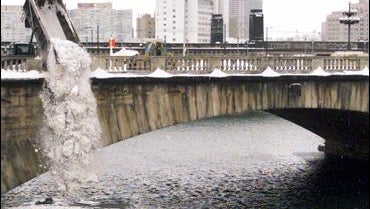Snow would drift in from the sides, so you would have to close those in, too. Essentially, you would need to build aboveground tunnels.
If you want a snow- and ice-free driveway, you can run radiant heat tubing (perhaps filled with antifreeze) under it. This is easier if you use the same sort of heating for the house.
In Toronto where a most high rise apartments have a ramp to underground parking, the ramps are cleared of snow and ice with heaters embedded in the concrete… for drainage they have the telltale fish bone pattern of groves directing the water down the middle to a drain. Of course the cost is spread over a hundred or more apartments, and there needs to be some way to turn the heat on when snow is forecast. Melting as it falls is more useful and safer than waiting. Draining to the heated Center prevents building a dam of ice along the edges. Not sure the optimal configuration for a driveway but fortunately few are perfectly flat.
Innumeracy is frankly as great a problem as illiteracy, but much more well hidden.
We think there’s a problem, but we haven’t the faintest idea how to quantify it.
Just two posts later?
Yeah, and not an uncommon event either.
Depressing, isn’t it? ![]()
Snow is a surprisingly good insulator. Heck, look at how warm it can get in an igloo.
That’s the air trapped in the snow, though, so I don’t know how significant a factor that is for deliberate melting? The fundamental issue is the large specific heat capacity and latent heat of fusion for water.
There’s an obvious soliution. Go to your local nuclear power plant and get some spent fuel rods. They always have a bunch that they’d like to get rid of. Bury them under road. You could break them up and bury a piece ever few meters to extend them.
Voila! Two problems solved!
What you have proposed is Toronto’s MetroMelt, which has been used by Toronto and Montreal for over forty years. As moves down the street, snow dumped into it’s tank is melted and drains down the storm sewers.
…by using an enormous amount of fuel.
Though these specs indicate better than 100% efficiency; at a fuel consumption rate of 86 gallons diesel fuel per hour, it should only be able to melt 35 tons of snow per hour, but it claims 60. It does say its tank must be filled water first, so I can only assume that it produces slush rather than completely melted snow.
To their credit, at least they could do math.
Diesel or gas are nowhere near as cost efficient at removing snow as solar as plowing and waiting for spring. It the cost of transporting to dumps that gets weighed against melting machines.
Back during the blizzards of '93 and '96 Philadelphia resorted to dumping snow off the bridges into the river.
As I’m regrettably subscribed to this zombie, I’ll just say:
Ah, a 1960’s Style Melt Ray!
sorry
